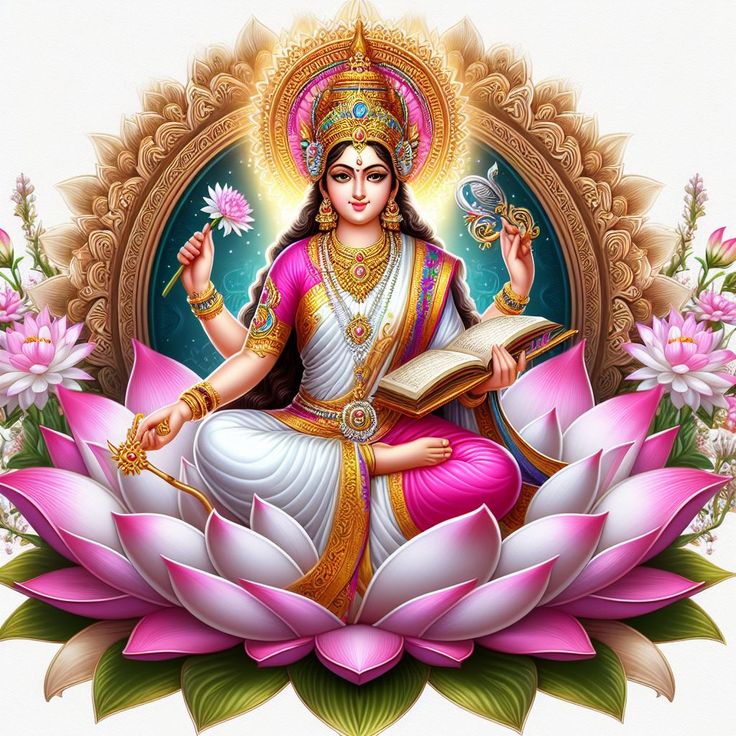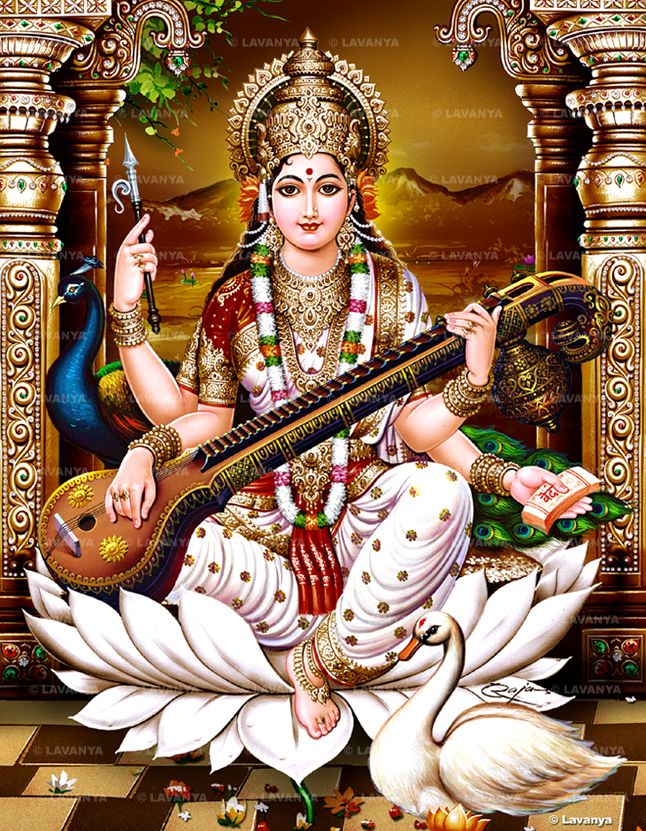Saraswati Puja : How to Perform Saraswati Puja at Home
Introduction
The arrival of spring marks the auspicious celebration of Vasant Panchami, a festival dedicated to the revered Goddess Saraswati – the embodiment of knowledge, wisdom, and the arts. As the Hindu calendar ushers in the Magha month, devotees across India eagerly anticipate this sacred day to honor the divine mother and seek her blessings for intellectual, creative, and academic pursuits.
Performing the Saraswati puja at home is a time-honored tradition that allows individuals to connect with the Goddess and invoke her grace. Whether you are a student, an artist, a professional, or simply someone seeking knowledge and enlightenment, this ritual holds immense significance in your spiritual and personal growth. In this comprehensive guide, we will delve into the step-by-step process of conducting a Saraswati puja at your residence, ensuring that you unlock the blessings of the Goddess and embark on a journey of endless possibilities.
Understanding the Significance of Saraswati Puja
Goddess Saraswati, the consort of Lord Brahma, is revered as the divine embodiment of knowledge, learning, and the arts. She is often depicted sitting on a lotus flower, holding a veena (a stringed musical instrument), and gracing her devotees with the gift of wisdom and creative expression. The Saraswati puja is a profound celebration that acknowledges the Goddess’s role in nurturing our intellectual and artistic faculties, enabling us to excel in our pursuits and unlock our true potential.
The festival of Vasant Panchami, which falls on the fifth day of the bright lunar fortnight in the month of Magha, is considered the most auspicious time to perform the Saraswati puja. This day is believed to mark the descent of the Goddess on earth, and devotees across India eagerly await this opportunity to seek her blessings and guidance.

Preparing for the Saraswati Puja
Before you begin the Saraswati puja, it is crucial to ensure that your home and puja space are properly prepared. Start by thoroughly cleaning and decluttering the designated puja room or area, as this helps create a serene and welcoming atmosphere for the Goddess. Arrange a raised platform or a small table to serve as the puja altar, and adorn it with a beautiful cloth or a colorful rangoli design.
Next, gather the necessary items for the puja ritual, which typically include:
- An idol or image of Goddess Saraswati
- An idol or image of Lord Ganesha (the remover of obstacles)
- A brass or copper kalash (a sacred water vessel) filled with water, mango leaves, and a betel leaf
- Flowers, preferably yellow marigolds or white lilies
- Incense sticks, camphor, and a diya (oil lamp)
- Vermilion (kumkum), turmeric, and rice
- Sweets, fruits, and other offerings for the Goddess
- A clean white cloth or a yellow cloth for the puja
- Pens, notebooks, and other academic or artistic tools
By meticulously preparing the puja space and gathering the necessary items, you set the stage for a harmonious and auspicious Saraswati puja.

The Saraswati Puja Ritual: Step-by-Step Guide
1. Purification and Invocation
Begin the puja by performing a purification ritual. Take a bath and wear clean, preferably yellow, clothing. Light the diya or oil lamp and incense sticks, creating a serene and fragrant atmosphere. Next, invoke the presence of Goddess Saraswati by chanting the following mantra:
“Om Saraswati Namastubhyam, Varade Kaamaroopini | Vidyarambham Karishyami, Siddhir Bhavatu Me Sada ||”
This mantra, which translates to “O Goddess Saraswati, I bow to you, the giver of boons and the one who takes any form. I am about to commence my learning, may I always be successful,” sets the tone for the puja and invites the Goddess’s divine presence.
2. Offering Asana (Seat) and Padya (Feet Washing)
After the invocation, offer a seat to the Goddess by placing a few flowers on the altar. Then, perform the padya ritual by pouring a small amount of water at the feet of the Saraswati idol or image, while chanting the following mantra:
“Gangodakam Nirmalam Cha Sarvasaugandha Samyutam | Pada Prakshalanarthaya Dattam Te Pratigrihyatam ||”
This mantra translates to “I offer you this pure Ganges water, infused with all fragrant scents, for the purpose of washing your feet. Kindly accept it.”
3. Arghya (Offering of Water) and Achamaniya (Sipping of Water)
Next, offer arghya, which is the water for the head ablution of the Goddess. Chant the following mantra while pouring the water:
“Arghyam Grihana Deveshi Gandhapushpakshataih Saha | Karunakara Me Devi Grihanarghya Namoastu Te ||”
This mantra means “O Goddess, accept this arghya along with fragrant flowers and grains. O compassionate Devi, I bow to you and request you to accept this offering.”
After the arghya, offer achamaniya, which is the water for sipping. Chant the following mantra while presenting the water:
“Sarvatirtha Samayuktam Sugandhi Nirmalam Jalam | Achamyatam Mayadattam Grihana Parameshwari ||”
This mantra translates to “O Supreme Goddess, please accept this pure, fragrant water, which is infused with the essence of all sacred rivers. I offer this water to you.”
4. Snana (Bathing) and Panchamrita Snana (Five Nectars Bath)
Proceed to the snana (bathing) ritual, where you offer water to the Goddess for her ritual bath. Chant the following mantra while pouring the water:
“Ganga Saraswati Revapayoshni Narmada Jalaih | Snapitoasi Maya Devi Tatha Shanti Kurushva Me ||”
This mantra means “O Goddess, I have bathed you with the waters of the Ganga, Saraswati, Reva, and Narmada rivers. May you bestow peace upon me.”
After the snana, perform the Panchamrita Snana, where you offer a mixture of five sacred substances – milk, curd, ghee, honey, and sugar – as a special bath for the Goddess. Chant the following mantra while offering the Panchamrita:
“Payo Dadhi Ghritam Chaiva Madhu Cha Sharkarayutam | Panchamritam Mayanitam Snanartham Pratigrihyatam ||”
This mantra translates to “I have brought this Panchamrita, consisting of milk, curd, ghee, honey, and sugar, for your ritual bath. Kindly accept it.”
5. Vastra (Offering of Clothes) and Gandha (Offering of Sandalwood Paste)
After the bathing rituals, offer the Goddess new and clean clothes, preferably in the color yellow, which is associated with knowledge and wisdom. Chant the following mantra while offering the clothes:
“Tantusantanasamyuktam Kala Kaushala Kalpitam | Sarvangabharanam Shreshtha Vasanam Paridhiyatam ||”
This mantra means “I offer you this exquisitely crafted garment, woven with the finest threads, as the most excellent attire to adorn your divine form.”
Next, apply sandalwood paste (gandha) to the Goddess’s idol or image, while chanting the following mantra:
“Shrikhanda Chandanam Divyam Gandhadhyam Sumanoharam | Vilepanam Sureshwari Chandanam Pratigrihyatam ||”
This mantra translates to “O Goddess, I offer you this divine, fragrant, and beautiful sandalwood paste as a decorative anointing.”
6. Saubhagya Dravya (Auspicious Substances) and Alankara (Ornaments)
Offer the Goddess auspicious substances such as turmeric, vermilion, and sindoor, which are associated with marital and spiritual well-being. Chant the following mantra while making this offering:
“Tambulapatram Mayaanitam Haridra Kumkumanjanam | Sinduralakchakam Dasve Saubhagyadravyamishwari ||”
This mantra means “O Goddess, I have brought betel leaves, turmeric, vermilion, and sindoor as auspicious substances. Kindly accept them.”
After the saubhagya dravya offering, adorn the Goddess with various ornaments, such as bangles, earrings, and a crown, while chanting the following mantra:
“Ratnakankanakechura Kanchi Kundala Nupuram | Muktaharam Kiritancha Grihanabharanani Me ||”
This mantra translates to “I offer you these beautiful ornaments, including bracelets, earrings, anklets, a pearl necklace, and a crown, as decorations for your divine form.”
7. Pushpa (Flower Offering) and Dhupa (Incense Offering)
Present the Goddess with a variety of fragrant flowers, such as marigolds, lilies, or roses, while chanting the following mantra:
“Malyadini Sugandhini Malyadini Vai Prabho | Mayaanitani Pushpani Grihana Parameshwari ||”
This mantra means “O Supreme Goddess, I have brought these fragrant flowers as an offering. Kindly accept them.”
Next, offer incense sticks (dhupa) to the Goddess, chanting the following mantra:
“Vanaspatirasodbhuto Gandhadhyo Gandha Uttamah | Aghreyah Narayani Dhupoayam Pratigrihyatam ||”
This mantra translates to “O Goddess Narayani, this incense, which has originated from a fragrant plant, is the best of all fragrances. I offer this dhupa to you, and request you to accept it.”
8. Deepa (Lamp Offering) and Naivedya (Food Offering)
Light a diya (oil lamp) and offer it to the Goddess, chanting the following mantra:
“Sajyam Cha Vartisamyuktam Vahnina Yojitam Maya | Deepam Grihana Deveshi Trailokyatimirapaham ||”
This mantra means “O Goddess, I have lit this lamp, which is equipped with a wick and fueled by oil. Kindly accept this deepa, which dispels the darkness of the three worlds.”
Finally, offer various sweets, fruits, and other delicacies as naivedya (food offering) to the Goddess, chanting the following mantra:
“Sharkaraghrita Samyuktam Madhura Svaduchottamam | Upahara Samayuktam Naivedyam Pratigrihyatam ||”
This mantra translates to “I have prepared this naivedya, which is made with sugar, ghee, and other delicious ingredients. Kindly accept this offering.”
9. Achamaniya (Sipping of Water) and Tambula (Betel Leaf Offering)
After the naivedya offering, perform the final achamaniya ritual by offering the Goddess water for sipping, chanting the following mantra:
“Eloshiralavangadi Karpuraparivasitam | Prashanartha Kritam Toyam Grihana Parameshwari ||”
This mantra means “O Supreme Goddess, I offer you this water, which is infused with the fragrance of cloves, cardamom, and camphor, for your pleasure and satisfaction.”
Conclude the puja by offering the Goddess a betel leaf (tambula) as a final gesture of reverence, chanting the following mantra:
“Pugi Phalam Mahadivyam Nagavallidalairyutam | Ela Churnadi Samyuktam Tambulam Pratigrihyatam ||”
This mantra translates to “I offer you this divine betel nut, wrapped in betel leaves, along with cardamom, cloves, and other fragrant ingredients. Kindly accept this tambula.”

Significance of Saraswati Puja
The Saraswati puja holds immense significance in the Hindu tradition, as it is believed to bestow devotees with the blessings of knowledge, wisdom, and artistic expression. By honoring the Goddess of learning, individuals can seek her grace to excel in their academic, professional, and creative pursuits.
The festival of Vasant Panchami, on which the Saraswati puja is typically performed, is also associated with the arrival of spring and the ripening of crops. This connection reinforces the idea of growth, renewal, and the blossoming of one’s intellectual and creative faculties under the Goddess’s divine influence.
Moreover, the puja is often conducted in educational institutions, schools, and universities, as it is believed to invoke the Goddess’s blessings for students and teachers alike, fostering an environment conducive to learning and academic success.
Saraswati Puja Vastu Considerations
According to the principles of Vastu Shastra, the ancient Indian science of architecture and spatial harmony, there are specific guidelines to be followed when setting up the Saraswati puja altar.
- The north direction is considered the most auspicious for the placement of the Goddess Saraswati’s idol or image. This direction is associated with knowledge, wisdom, and intellectual growth.
- The ideal posture for the Goddess Saraswati is seated on a lotus flower, as this symbolizes purity, divinity, and spiritual enlightenment. Avoid using an idol or image where the Goddess is depicted in a standing posture.
- It is recommended to avoid placing two idols or images of the Goddess Saraswati together, as this can create an imbalance in the energy flow.
By adhering to these Vastu principles, you can ensure that your Saraswati puja is conducted in a harmonious and auspicious manner, maximizing the Goddess’s blessings and their positive impact on your life.

Saraswati Puja Decoration Ideas
The Saraswati puja is an occasion to transform your home into a vibrant and visually captivating space that reflects the essence of the Goddess. Here are some creative decoration ideas to enhance the puja experience:
Marigold Flowers
As the Vasant Panchami festival is associated with the color yellow, adorn your home with vibrant marigold flowers. These cheerful blooms can be used to create garlands, flower arrangements, and even rangoli designs around the puja altar.
Rangoli Designs
Elaborate rangoli designs featuring motifs related to Goddess Saraswati, such as swans, veenas, or books, can add a touch of artistic flair to your puja space. These intricate patterns can be created using colorful powders, flowers, or even rice grains.
Door Hangings and Torans
Decorate the entrance of your home with beautiful door hangings or torans made of beads, bells, and other ornamental elements. These can help create a warm and welcoming ambiance for the Goddess’s arrival.
Backdrops and Outdoor Decorations
Consider creating a vibrant backdrop for the puja altar using colorful fabrics or paper streamers. You can also extend the festivities to your outdoor spaces by adorning them with kites, yellow flowers, and other seasonal decorations.
By incorporating these creative elements, you can transform your home into a harmonious and visually captivating space that honors the essence of Goddess Saraswati and the Vasant Panchami celebration.
Conclusion
The Saraswati puja is a profound and time-honored tradition that celebrates the divine essence of knowledge, wisdom, and the arts. By meticulously following the puja rituals and honoring the Goddess with reverence, devotees can unlock the blessings of Saraswati and embark on a journey of intellectual and creative fulfillment.
Whether you are a student seeking academic excellence, an artist yearning for inspiration, or a professional striving for success, the Saraswati puja holds the power to transform your life. By aligning your intentions with the Goddess’s divine attributes and embracing the principles of Vastu Shastra, you can create a harmonious and auspicious environment that fosters growth, prosperity, and the realization of your highest potential.
As you conclude the Saraswati puja, take a moment to reflect on the insights and wisdom you have gained. Embrace the Goddess’s grace, and let her blessings guide you in all your endeavors. Remember that the true essence of the Saraswati puja lies not only in the rituals but also in the cultivation of a lifelong dedication to learning, creativity, and the pursuit of knowledge.
May the Goddess Saraswati bestow upon you the gifts of intellect, artistic expression, and the unwavering determination to excel in all your undertakings. Embark on this journey of enlightenment with reverence, humility, and a deep appreciation for the divine feminine energy that permeates our world.
#Saraswatipuja #Saraswatipooja #home #house #howto #how







